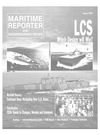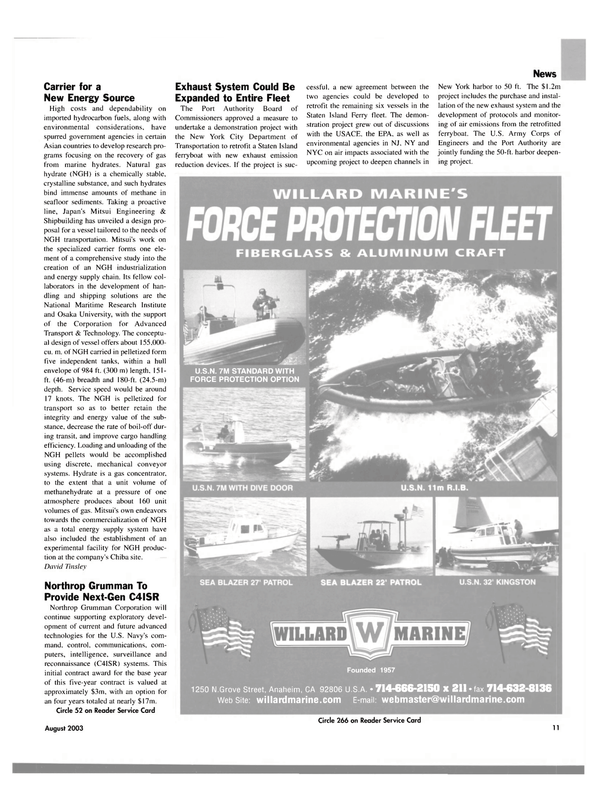
Carrier for a New Energy Source
High costs and dependability on imported hydrocarbon fuels, along with environmental considerations, have spurred government agencies in certain Asian countries to develop research programs focusing on the recovery of gas from marine hydrates. Natural gas hydrate (NGH) is a chemically stable, crystalline substance, and such hydrates bind immense amounts of methane in seafloor sediments. Taking a proactive line, Japan's Mitsui Engineering & Shipbuilding has unveiled a design proposal for a vessel tailored to the needs of NGH transportation. Mitsui's work on the specialized carrier forms one element of a comprehensive study into the creation of an NGH industrialization and energy supply chain. Its fellow collaborators in the development of handling and shipping solutions are the National Maritime Research Institute and Osaka University, with the support of the Corporation for Advanced Transport & Technology. The conceptual design of vessel offers about 155,000- cu. m. of NGH carried in pelletized form five independent tanks, within a hull envelope of 984 ft. (300 m) length, 151- ft. (46-m) breadth and 180-ft. (24.5-m) depth. Service speed would be around 17 knots. The NGH is pelletized for transport so as to better retain the integrity and energy value of the substance, decrease the rate of boil-off during transit, and improve cargo handling efficiency. Loading and unloading of the NGH pellets would be accomplished using discrete, mechanical conveyor systems. Hydrate is a gas concentrator, to the extent that a unit volume of methanehydrate at a pressure of one atmosphere produces about 160 unit volumes of gas. Mitsui's own endeavors towards the commercialization of NGH as a total energy supply system have also included the establishment of an experimental facility for NGH production at the company's Chiba site.
David Tinsley
Read Carrier for a New Energy Source in Pdf, Flash or Html5 edition of August 2003 Maritime Reporter
Other stories from August 2003 issue
Content
- Letters page: 9
- Admiral Loy, Grace Allen Receive Silver Bell Honors page: 10
- Carrier for a New Energy Source page: 11
- Exhaust System Could Be Expanded to Entire Fleet page: 11
- Bollinger Delivers Supply Boat to Seacor page: 12
- Confused Seas page: 14
- Concordia Again Leads Tanker Innovation page: 16
- Intermarine Launches G5 Oltramonti page: 17
- Bottom Line: It's Not Just A Paint Job page: 18
- Hempel Extends Range page: 18
- Nichols Bros. Launch Sternwheeler Cruise Ship page: 23
- Keppel to Deliver Maersk Rig Early page: 23
- Evergreen Orders 10 Post-Panamax Containerships page: 24
- USS Ronald Reagan Commissioned page: 25
- Littoral Combat Ship: It's Down to 3 page: 26
- Manitowoc, Kvichak Team for USCG Boats page: 29
- MV Manukai Christened at Philly Shipyard page: 30
- Emergency Sends S.S. Matsonia to Pearl Harbor Yard page: 30
- SENESCO Provides Major Facelift for NOAA page: 31
- Northrop Grumman Christens San Antonio page: 31
- Power to the Surveyor page: 32
- Wartsila: A Fountain of Ideas page: 33
- What Should be the Role of Class? page: 34
- RIB Report Northwind's Enforcer Provides Special Services page: 38
- Rough Water "New RIB on the Block" page: 40
- Salvors Forge Their Way into the Future page: 42
- Geislinger Delivers Record Sized Coupling page: 51
- Alstom Alspa Drive Fitted on Reasearch Vessel page: 51
- DNV's Five Points Fight Substandard Ships page: 55
- Strength Through Unity page: 55


